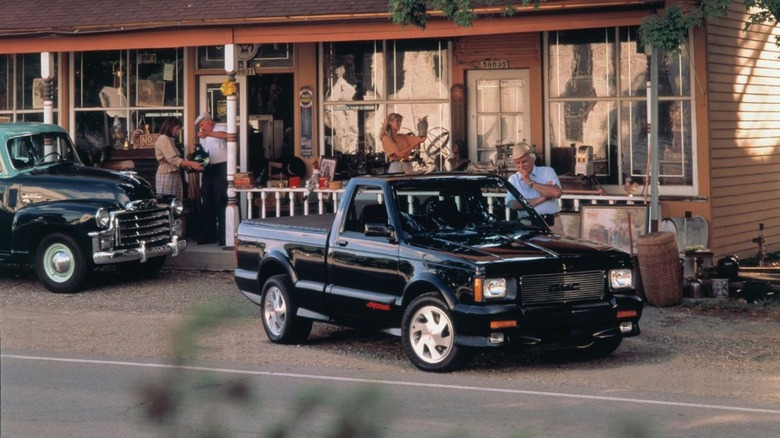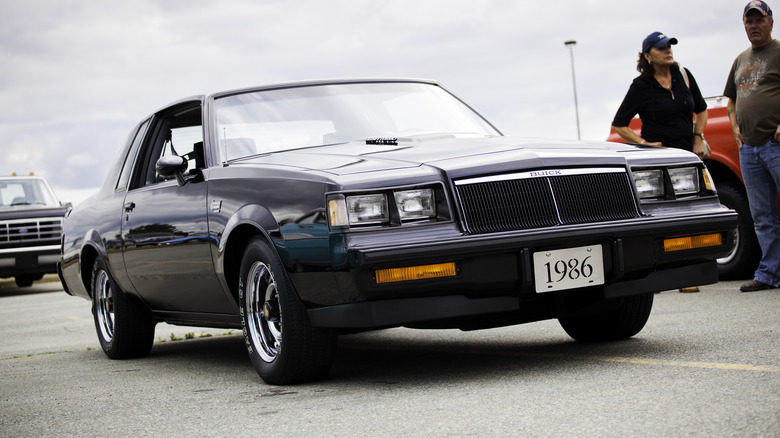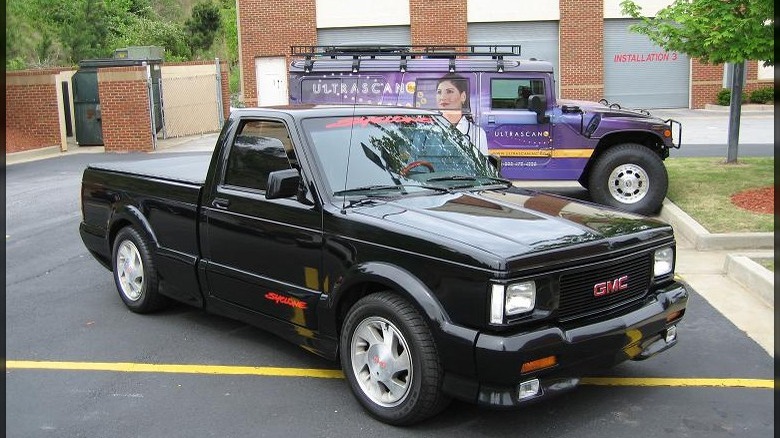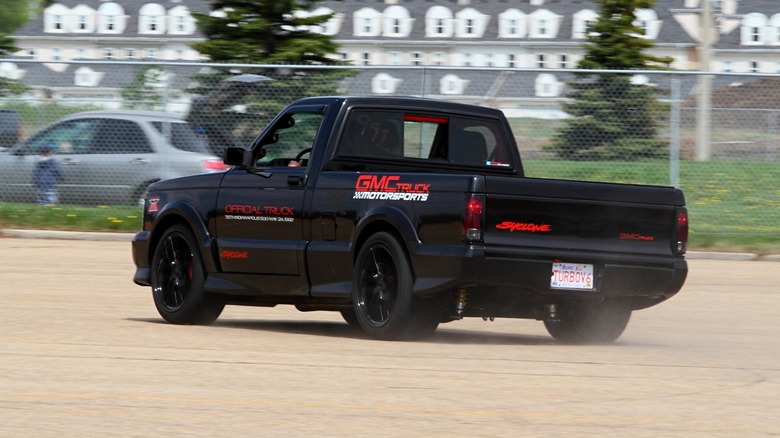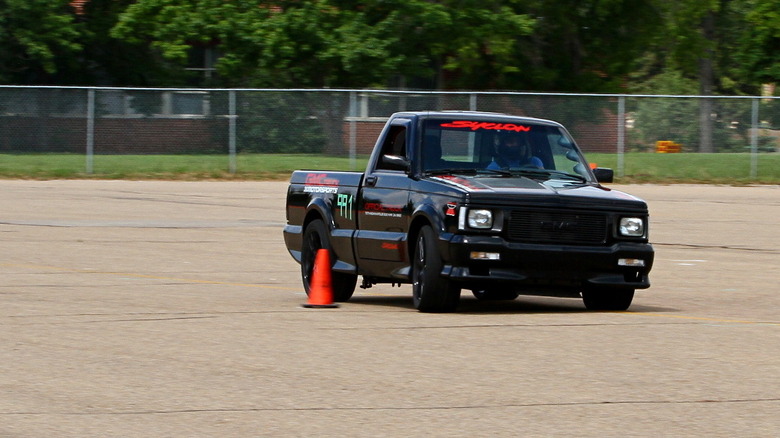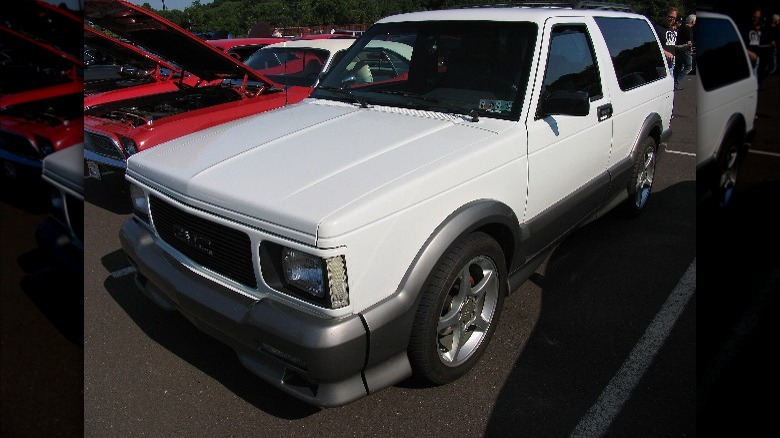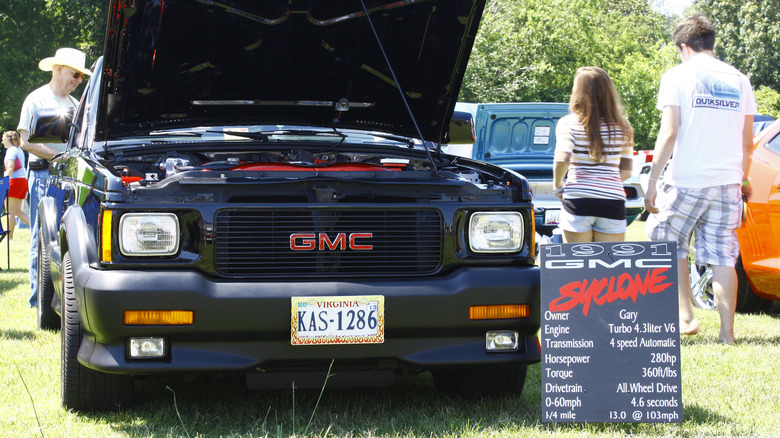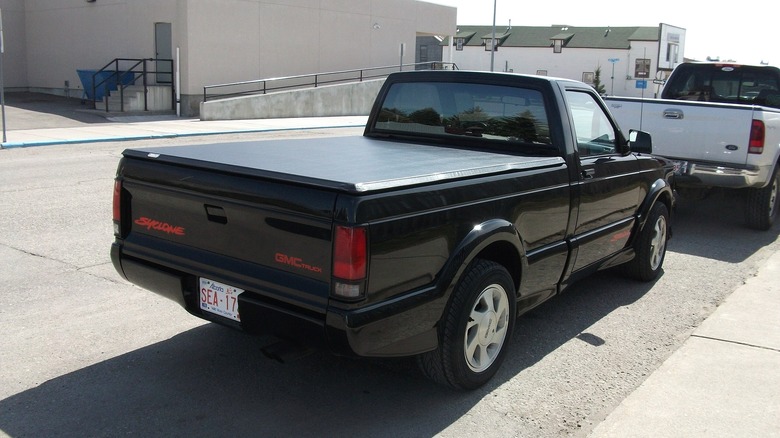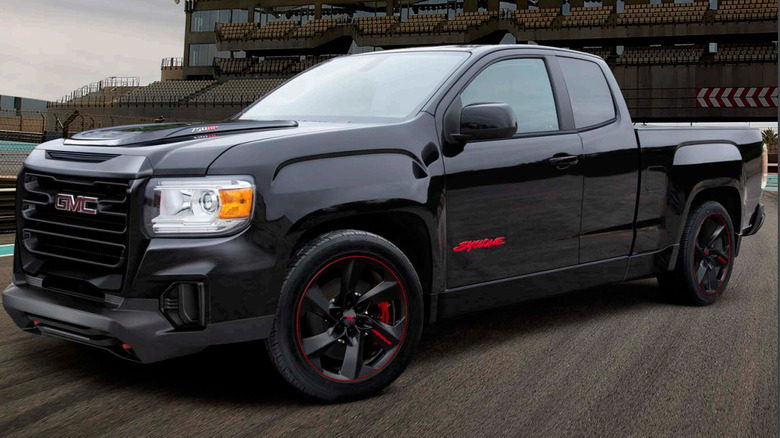GMC Syclone: The Story Behind The Classic High Performance Pick-Up Truck
In the era of V12-powered SUVs with Prancing Horse badges and 700 horsepower pickup trucks, perhaps a hot rod GMC truck is a little less shocking. It's easy to overlook how unprecedented it was upon launch — a major truck company had never produced anything like it before. This was a compact pickup with enough grunt under the hood to keep up with supercars in a straight line, and from a brand not known for its performance prowess.
Although it's now one of GMC's most famous nameplates, the truck wasn't initially destined to wear the manufacturer's badge at all. In fact, the prototype was rejected by other GM brands before eventually GMC saw the potential in the idea. In the decades since, almost every major truck manufacturer has unveiled a sports truck, with some, such as the Dodge Ram SRT-10, even crazier than the Syclone. However, those trucks would arguably never have happened were it not for GMC.
The Buick that wasn't
The Syclone was first unveiled to a surprised crowd at the 1989 North American International Auto Show, but the idea was first touted two years earlier by Buick engineers. The Grand National had just been axed, and so the engineers decided to find another use for its 3.8-liter turbo V6 engine. It was bolted into a Chevrolet S10, and subsequently presented to Chevy's management as a potential production vehicle. Bosses weren't interested in the idea, so it was brought over to GMC instead. While GMC's top brass agreed the truck had potential, they took issue with the idea of using the Buick V6 as a powerplant.
It wouldn't be financially viable to adapt it for production in the truck, and so the project pivoted to using the 4.3-liter V6 already in use in GMC's trucks instead. The existing engine would be upgraded to produce supercar-killing power, without needing quite as extortionate a budget.
Outsourced construction
Even using the existing GMC engine, bosses still considered the project's cost to be too high. It was estimated that converting production facilities to build the truck would take years, and potentially leave it outdated as soon as it launched. As a result, another method of production was needed. It was decided that construction would be outsourced, and the project was put out for tender. Two potential constructors responded: Production Automotive Services and ASC McLaren.
PAS won the contract as it could accommodate building the truck with an all-wheel drive system. Sending power to all four wheels was considered a necessity considering the lack of weight at the rear, with the system in question plucked from a Chevy van. As well as keeping costs down, outsourcing construction also cut down the time that was needed for the truck to hit the market. By the time it was unveiled in New York in 1989, it was just two years away from hitting dealerships.
[Featured image by Willyson via Wikimedia Commons | Cropped and scaled | Public Domain]
Straight-line dominance
The Syclone's biggest talent was dominating rivals in a straight line, but that came with some compromises. In a 1991 Car and Driver test comparing the GMC and a Ferrari 348 TS, the truck beat the Prancing Horse over a quarter mile. That, in itself, was a commendable feat, and has since been enshrined into the truck's folklore, although the magazine did note some of the truck's limitations became apparent during the test.
The biggest difference between the two was immediately off the line – the Syclone pulled away by around two car lengths, seemingly leaving the Ferrari in the dust. However, towards the end of the quarter mile, the Ferrari regained ground, catching the truck, but not fast enough to beat it by the time it flew past the quarter mile marker. Indeed, given any longer stretch of asphalt, the Ferrari would have emerged victorious. If nothing else, its 166 mph top speed, compared to the GMC's 126 mph, would have seen it easily pull away.
Car and Driver also noted that the Ferrari was 6 mph faster at the quarter-mile marker, and that testing took place on a cool day. In warmer temperatures, noted the magazine, the Syclone was prone to "significant power losses." So yes, the GMC did beat the Ferrari, although not quite as decisively as it might first appear.
[Featured image by Grant.C via Wikimedia Commons | Cropped and scaled | CC BY 2.0]
A cut-price predator
Those technicalities shrink into insignificance, however, when you consider just how much cheaper the GMC was than the Ferrari. It started at roughly $26,000, whereas the Italian vehicle cost nearly $100,000 more, with an MSRP of $122,000. This is where the Syclone was most remarkable: it boasted supercar-rivaling performance (albeit with some caveats), yet it cost a tiny fraction of the price. It's easy to assume that such a combination would have made it a sales hit, but that wasn't the case.
A total of 2,998 Syclones were built, with all but three of those built for the 1991 model year. The vast majority were sold in America, but 113 were sent to Saudi Arabia. They proved extremely difficult to sell, and eventually, 31 of those were shipped back to the U.S. as Middle Eastern dealers didn't want them. One truck was reportedly dismantled for parts, while the other 30 were sold off internally to GMC staff.
[Featured image by Grant.C via Wikimedia Commons | Cropped and scaled | CC BY 2.0]
Syclones and Typhoons
Alongside the Sonoma-based Syclone pickup, GMC had also developed an SUV variant based on the Jimmy. Christened the Typhoon, the vehicle went into production as soon as Syclone production had ended. It was built in slightly larger numbers than its pickup counterpart, with just under 4,700 examples leaving the PAS factory between 1992 and 1993. The Syclone and Typhoon are visually very similar, and share many of the same internals, although the extra weight of the Typhoon made it marginally slower.
However, the Typhoon was ironically the more practical of the two, with seating for four people and a plush leather interior to differentiate it from lesser Jimmy variants. It was, although its makers might not have realized it at the time, a very pioneering vehicle. The idea of a performance SUV is nothing special today, but thirty years ago, it was still largely new territory, and its success proved that the segment could potentially be a worthwhile one for other manufacturers to explore.
Muscle, but no car
Neither the Typhoon nor the Syclone's performance feats would have been possible were it not for the turbocharged 4.3-liter V6 that lay under the hoods of both. Considering the engine derived from an everyday workhorse mill, it packed some highly impressive stats: 280 horsepower at 4,200 rpm, and 350 lb-ft of torque at 3,500 rpm. For context, the '87 Buick Grand National Regal GNX, whose retirement had sparked the idea for the Syclone's development, made 276 horsepower and 360 lb-ft of torque.
The Syclone's PAS-upgraded engine allowed for an officially claimed 0-60 mph time of less than five seconds, and a quarter mile from a standing start in 13.6 seconds. Those stats were also extremely similar to the '87 Regal GNX's claimed times. The truck's power was sent to the ground through a four-speed automatic transmission, while beefed-up brakes ensured it could stop as rapidly as it accelerated.
Practical limitations
The performance prowess was undeniable, but the Syclone wasn't quite as appealing when it came to practicality. After all, the reason so many Americans buy pickups is because they're inherently capable, both at carrying larger loads than a regular passenger car and navigating tougher terrain if needed. The Syclone was good at neither of those things. It was only rated for a 500-pound payload and towing capacity of 2,000 pounds. For context, the '91 Toyota Camry could tow the same weight.
Its low ride height and street suspension meant that it was no good on any surface besides smooth tarmac. Neither was a dealbreaker for those who bought one, and at the end of the day, this wasn't a truck ever designed with practicality in mind, though it did narrow down the potential buyer pool considerably. After all, there were plenty of people who couldn't stomach the idea of buying a $26,000 truck that couldn't do "truck stuff."
[Featured image by Dave_7 via Wikimedia Commons | Cropped and scaled | CC BY 2.0]
An unofficial revival
While there has never been an official follow-up to the Syclone, there have been unofficial attempts at reviving the nameplate in recent years. One such "unofficial Syclone" is produced by Specialty Vehicle Engineering, who take a GMC Canyon and swap in a supercharged 5.3-liter V8 complete with race-inspired performance parts. It's good for 750 horsepower and 600 lb-ft of torque – close to three times the amount of horses on offer in the original. Much like the '90s Syclone, the SVE truck gets upgraded, lowered suspension, and a suitably durable automatic transmission to handle the extra power.
While the truck features Syclone badging, it's not officially sanctioned, and it's not freely available for buyers either. The vehicle was unveiled in 2022, and production is limited to just 50 units. With the truck industry now focusing most of its development efforts on electrification (the GMC Sierra EV is set to arrive soon), it seems unlikely there will ever be an official continuation, unless GMC takes the radical step of offering an electric hot rod pickup. Whether such a truck would be received well by buyers is another matter, but an electric Syclone would certainly be a good way to generate conversation about the brand's trucks, just like its predecessor did 30 years ago. For now, the classic Syclone remains a unicorn without an imminent successor.
